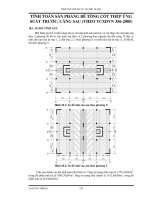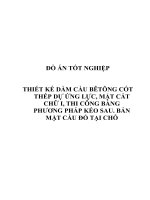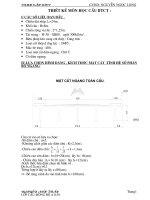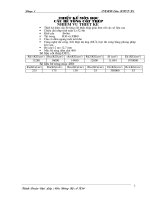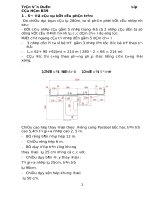Thiết kế dầm thép theo TCVN 11823 2017
Bạn đang xem bản rút gọn của tài liệu. Xem và tải ngay bản đầy đủ của tài liệu tại đây (798.63 KB, 35 trang )
MINISTRY OF EDUCATION AND TRAINING
UNIVERSITY OF TRANSPORT AND COMMUNICATIONS
PARTIAL PROJECT OF
STEEL BRIDGE DESIGN
Student :
ID
:
Class
:
Nguyen Thien Long
Lecturer :
Hanoi, 6/2021
Steel Bridge Design
Nguyen Thien Long - 172603217
Contents
CHAPTER 1: INTRODUCTION .................................................................................... 5
I.
INPUT DATA ............................................................................................................. 5
II.
DESIGNED DATA ..................................................................................................... 5
1.
Designed method and loading ................................................................................ 5
2.
Materials................................................................................................................. 5
2.1.
Concrete .......................................................................................................... 5
2.2.
Girder steel ...................................................................................................... 5
2.3.
Designed cross section .................................................................................... 6
CHAPTER 2: INTERNAL FORCE CALCULATION AND COMBINATION FOR
MAIN GIRDER ............................................................................................................... 10
I.
GEOMETRICAL CHARACTERISTICS ................................................................. 10
1.1. Calculation stages ................................................................................................ 10
1.2. Calculate effective flange width .......................................................................... 10
1.2.1.
Interior beam .............................................................................................. 10
1.2.2.
Exterior beam ............................................................................................. 10
1.3. Geometrical characteristic of stage 1 ................................................................... 10
1.4. Transverse distribution coefficient calculation .................................................... 12
1.4.1.
Longitudinal stiffness coefficient calculation ............................................ 12
1.4.2.
Calculate moment distribution coefficient................................................. 12
1.4.3.
Calculate shear force distribution coefficient ............................................ 14
1.4.4.
Calculate pedestrian path distribution coefficient ..................................... 14
1.4.5.
Calculate distribution coefficient in fatigue limit state ............................. 15
1.4.6.
Calculate moment distribution coefficient................................................. 15
1.4.7.
Calculate shear force distribution coefficient ............................................ 15
1.4.8.
Calculate defection distribution coefficient ............................................... 16
1.4.9.
Table distribution coefficient ..................................................................... 16
1.5. Geometrical characteristic of stage 2 ................................................................... 16
II.
1.5.1.
Short term loading(n) ................................................................................. 16
1.5.2.
Long term loading(3n) ............................................................................... 17
LOADING ................................................................................................................. 18
2
Steel Bridge Design
Nguyen Thien Long - 172603217
2.1. Dead load ............................................................................................................. 18
2.1.1.
DC .............................................................................................................. 19
2.1.2.
DW ............................................................................................................. 19
2.1.3.
Total dead load........................................................................................... 19
2.1.4.
Dead load in limit state .............................................................................. 20
2.2. Live load .............................................................................................................. 21
2.2.1.
Loading combination and coefficient ........................................................ 22
2.2.2.
Strength limit state I ................................................................................... 23
2.2.3.
Service limit state II ................................................................................... 23
2.2.4.
Fatigue limit state II ................................................................................... 24
CHAPTER 3: CALCULATED FOR DESIGN GIRDER ........................................... 25
I.
CHARACTERISTICS PROPRERTIES OF CROSS SECTION .............................. 25
1.1. Plastic moment ..................................................................................................... 25
1.1.1.
Determine plastic force .............................................................................. 25
1.1.2.
Determine plastic neutral axis(PNA) ......................................................... 25
1.1.3.
Determine plastic moment ......................................................................... 26
1.2. Yielding moment.................................................................................................. 26
II.
1.2.1.
Determine for components moment .......................................................... 26
1.2.2.
Determine yielding moment ...................................................................... 27
CHECKING IN LIMIT STATE I ............................................................................. 27
2.1. Bending moment .................................................................................................. 27
III.
2.1.1.
Checking the plastic properties .................................................................. 27
2.1.2.
Checking the ability to apply Part 6, appendix A ...................................... 27
2.1.3.
Checking bending resistance for composite cross section ......................... 27
2.1.4.
Checking for shearing resistance ............................................................... 28
CHECKING IN SERVICE LIMIT STATE II ........................................................ 29
3.1. Elastic deformation .............................................................................................. 29
3.2. Unrestorable deformation related to bending ...................................................... 29
IV.
FATIGUE LIMIT STATE AND CRACKING ....................................................... 29
4.1. Fatigue related to loading..................................................................................... 30
3
Steel Bridge Design
Nguyen Thien Long - 172603217
4.2. Fatigue stress calculation ..................................................................................... 30
V.
4.2.1.
Stress in bottom edge of top flange ........................................................... 30
4.2.2.
Stress in top edge of bottom flange ........................................................... 30
ULTIMATE FATIGUE REQUIREMENT FOR WEB ............................................ 31
CHAPTER 4: DESIGN FOR STIFFENERS AND SHEAR CONNECTORS .......... 32
I.
SHEAR CONNECTORS .......................................................................................... 32
1.1. Composition ......................................................................................................... 32
1.2. Fatigue Limit State(FLS) ..................................................................................... 33
1.3. Strength limit state ............................................................................................... 34
4
Steel Bridge Design
Nguyen Thien Long - 172603217
CHAPTER 1: INTRODUCTION
I.
II.
1.
-
INPUT DATA
Length of span, L: 36(m).
Carriageway width, Bc: 7(m).
Pedestrian path width, Bp: 1.5(m).
Design load: HL – 93, PL 3.10-3 (MPa).
Superstructure: Composite steel I girder bridge.
Type of connection: Bolted Connections.
Concrete type: 30(MPa).
Steel type: G40, G60 or the same.
Other data:
DESIGNED DATA
Designed method and loading
This project was designed based on specification TCVN 11823 – 2017 and some
reference books.
- Design load: HL – 93; PL 3.10-3 MPa.
- Span structure: 1 x 36(m).
- Bridge width: 11(m).
2. Materials
2.1. Concrete
According to C3.5.1.B6:
- Specific weight of wearing coat:
𝛾𝐷𝑊 = 2250(𝑘𝑔⁄𝑚3 ) = 2250 × 9.81 × 10−3 = 22.0725(𝑘𝑁⁄𝑚3 )
- Specific weight of bridge slab’s concrete:
𝛾𝐶 = 2450(𝑘𝑔⁄𝑚3 ) = 2450 × 9.81 × 10−3 = 24.0345(𝑘𝑁⁄𝑚3 )
- Compressive strength of concrete at 28 days:
𝑓𝑐′ = 30(𝑀𝑃𝑎)
- Elastic modulus of slab concrete( C5.4.2.4.E8):
0.33
𝐸𝑐 = 0.0017 × 𝐾1 × 𝑊𝑐2 × 𝑓 ′ 𝑐
𝐸𝑐 = 0.0017 × 1 × 24502 × 300.33 = 31349.535(𝑀𝑃𝑎)
2.2. Girder steel
- Cross section: I girder.
- Specification: ASTM A709M, Grade 50(345MPa)
- Specific weight of steel(C3.5.1):
𝛾𝑆 = 7850(𝑘𝑔⁄𝑚3 ) = 77.0085(𝑘𝑁⁄𝑚3 )
- Elastic modulus of steel(C5.4.3.2):
𝐸𝑆 = 200000(𝑀𝑃𝑎)
- Minimum tensile strength of steel(C6.4.1):
𝑓𝑢 = 450(𝑀𝑃𝑎)
5
Steel Bridge Design
Nguyen Thien Long - 172603217
-
Minimum plastic strength of steel(C6.4.1):
𝐹𝑦 = 𝐹𝑦𝑏 = 𝐹𝑦𝑤 = 𝐹𝑦𝑡 = 345(𝑀𝑃𝑎)
Where: Fyt, Fyw, Fyc is minimum tensile strength of tensile flange, web and
compressive flange, respectively.
- Convertible coefficient for elastic modulus, approximately(C6.10.1.1.1.2):
+, For short – term loading: n = 8,
+, For long – term loading: n = 24.
2.3. Designed cross section
2.3.1. Deck slab
- Bases on C9.7.1.1, minimum thickness of deck slab is 175(mm).
- According to C2.5.6.3.B2, minimum thickness of deck slab is:
1.2 × (𝑆 + 3000) 1.2 × (3000 + 3000)
𝑡𝑆 ≥
=
= 240(𝑚𝑚)
30
30
Where:
+, S: Spacing between 2 main girders, S = 3000(mm).
- So, choose thickness of deck slab ts = 250(mm).
2.3.2. Girder cross section
Because the girder was bended on the whole length by positive moment, so choose
one of cross section for all location.
Note
Name
Dimension
Width(mm)
bv
Top haunch width
0
bt
Top flange width
360
tw
Web thickness
15
bb
Bottom flange width
420
Height(mm)
tv
Haunch thickness
50
tt
Top flange thickness
20
D = hw
Web height
1550
tb
Bottom flange thickness
30
h1
Total steel girder height
1600
Total concrete slab
h2
300
height
6
Steel Bridge Design
Nguyen Thien Long - 172603217
Figure 1. I steel cross section.
2.3.3. Wearing coat
- Resistance water layer: 5(mm) thickness.
- Asphalt concrete pavement layer: 70(mm) thickness.
- Total wearing coat thickness: 75(mm).
2.3.4. Parapet
Parapet’s dimensions would be indicated on the figure, total area of parapet:
Apar = 387500 mm2.
Figure 2. Parapet cross section.
7
Steel Bridge Design
Nguyen Thien Long - 172603217
2.3.5. Span cross section
Span cross section include 4 main girders, dimensions as the table:
Note
Name
Dimension
Unit
S
Girders spacing
3
m
Se
Overhang
1
m
Total width of
W
11
m
bridge
Carriageway
Wcar
7
m
width
Pedestrian path
Wpes
1.5
m
width
Wpar
Parapet width
0.5
m
Figure 3. Span cross section
2.3.6. Checking limit dimension for main girder
2.3.6.1. Web height
- Based on C2.5.2.6.3.B2, minimum height for I girder is 0.033L (Simple beam).
- So, 𝐿𝑚𝑖𝑛 = 0.033 × 36 = 1.188(𝑚) = 1188(𝑚𝑚).
- Check: ℎ𝑤 = 1550(𝑚𝑚) > 𝐿𝑚𝑖𝑛 = 1188(𝑚𝑚) → TRUE.
2.3.6.2. Web thickness
𝐷
- Based on C6.10.2.1.1 without using longitudinal stiffeners: ≤ 150(𝑚𝑚)
𝑡𝑤
-
Check:
𝐷
𝑡𝑤
=
1550
15
= 103.333(𝑚𝑚) < 150(𝑚𝑚) → TRUE.
2.3.6.3. Flange dimensions
- Based on C6.10.2.2, 4 conditions should be checked.
-
C6.10.2.2.E95:
𝑏𝑓
2×𝑡𝑓
≤ 12
8
Steel Bridge Design
Nguyen Thien Long - 172603217
+, For top flange,
𝑏𝑓
=
2×𝑡𝑓
𝑏𝑓
+, For bottom flanger,
-
C6.10.2.2.E96: 𝑏𝑓 ≥
360
2×20
2×𝑡𝑓
=
= 9 ≤ 12 → TRUE.
420
2×30
= 7 ≤ 12 → TRUE.
𝐷
6
+, For top flange, 𝑏𝑓 ≥
𝐷
6
↔ 360 ≥
+, For bottom flanger, 𝑏𝑓 ≥
𝐷
6
1550
6
↔ 420 ≥
= 258.33 → TRUE.
1550
6
= 258.33 → TRUE.
-
C6.10.2.2.E97: 𝑡𝑓 ≥ 1.1 × 𝑡𝑤
+, For top flange, 𝑡𝑓 ≥ 1.1 × 𝑡𝑤 ↔ 20 ≥ 1.1 × 15 = 16.5 → TRUE.
+, For bottom flanger, 𝑡𝑓 ≥ 1.1 × 𝑡𝑤 ↔ 30 ≥ 1.1 × 15 = 16.5 → TRUE.
-
C6.10.2.2.E98: 0.1 ≤
-
Check: 0.1 ≤
𝐼𝑦𝑐
𝐼𝑦𝑡
𝐼𝑦𝑐
𝐼𝑦𝑡
≤ 10
≤ 10 ↔ 0.1 ≤
240000
945000
= 0.254 ≤ 10 → TRUE.
9
Steel Bridge Design
Nguyen Thien Long - 172603217
CHAPTER 2: INTERNAL FORCE CALCULATION AND
COMBINATION FOR MAIN GIRDER
I.
GEOMETRICAL CHARACTERISTICS
1.1. Calculation stages
- Stage 1: Non – composite steel girder cross section
- Stage 2:
+, Composite girder cross section under short – term loading(Modulus coefficient
n).
+, Composite girder cross section under long – term loading(Modulus coefficient
3n).
Calculate geometrical characteristic for stage 1 in this chapter. About stage 2,
calculate after determined transverse distribution coefficient.
1.2. Calculate effective flange width
Effective span length: 𝐿𝑒𝑓𝑓 = 35(𝑚).
1.2.1. Interior beam
1
1
effective span length: 𝐵𝑒1 = × 35 = 8.75(𝑚) = 8750(𝑚𝑚).
4
-
4
1
12 times of deck slab thickness plus maximum of (Web thickness; top flange
2
1
width): 𝐵𝑒2 = 12 × 300 + max (15; × 360) = 3780(𝑚𝑚).
2
Spacing of girders: 𝐵𝑒3 = 𝑆 = 3000(𝑚𝑚).
Takes the minimum value to set for effective flange width:
𝐵𝑒𝑖 = 𝐵𝑒3 = 3000(𝑚𝑚)
1.2.2. Exterior beam
1
1
effective span length: 𝐵𝑒1 = × 35 = 4.375(𝑚) = 4375(𝑚𝑚).
-
8
-
8
1
1
2
4
6 times of deck slab thickness plus maximum of ( Web thickness; top flange
1
1
2
4
width): 𝐵𝑒2 = 6 × 300 + max ( × 15; × 360) = 1890(𝑚𝑚).
Overhang: 𝐵𝑒3 = 𝑆𝑒 = 2500(𝑚𝑚).
Takes the minimum value to set for effective flange width:
𝐵𝑒𝑒 = 𝐵𝑒3 = 2500(𝑚𝑚)
1.3. Geometrical characteristic of stage 1
Set up coordination system:
- X axis: Coincide with neutral axis of web.
- Y axis: Symmetrical axis.
-
10
Steel Bridge Design
Nguyen Thien Long - 172603217
Cross section
Width
-
-
Thickness
Area
A
mm2
Coefficient
y
𝐴×𝑦
mm
mm3
Inertia moment
I0i
Ix
mm4
mm4
Unit
mm
mm
Top
360
20
7200 785 5652000
240000
4437060000
flange
Web 1550
15
23250
0
0
4654843750 4654843750
Bottom
420
30
12600 -790 -9954000
945000
7864605000
flange
Total
43050
-4302000
16956508750
Where:
+, A: Components area(mm2).
+, y: Distance from neutral axis of web to component centre(mm).
Distance from neutral axis of web to cross section centre:
∑ 𝐴 × 𝑦 −4302000
𝑦𝑁𝐶 =
=
= −99.930314(𝑚𝑚).
∑𝐴
43050
Inertia moment of cross section with neutral axis of cross section:
𝐼𝑁𝐶 = ∑ 𝐼𝑥 − 𝑦𝑁𝐶 × ∑ 𝐴 × 𝑦
-
-
-
-
= 16956508750 − (−99.930314) × (−4302000)
= 16526608541(𝑚𝑚4 ).
Distance from neutral axis to top edge of steel girder:
𝑡
𝑦𝑁𝐶
= 0.5 × ℎ𝑤 + 𝑡𝑡 − 𝑦𝑁𝐶 = 0.5 × 1550 + 20 − (−99.930314)
= 894.9303136(𝑚𝑚).
Distance from neutral axis to bottom edge of steel girder:
𝑐
𝑦𝑁𝐶
= 0.5 × ℎ𝑤 + 𝑡𝑏 − 𝑦𝑁𝐶 = 0.5 × 1550 + 30 − (−99.930314)
= 705.0696864(𝑚𝑚).
Static moment of cross section with axis through top edge of steel girder:
𝐼𝑁𝐶 16526608541
𝑡
𝑆𝑁𝐶
= 𝑡 =
= 18466922.27(𝑚𝑚3 ).
𝑦𝑁𝐶
894.9303136
Static moment of cross section with axis through bottom edge of steel girder:
𝐼𝑁𝐶 16526608541
𝑐
𝑆𝑁𝐶
= 𝑐 =
= 23439681.01(𝑚𝑚3 ).
𝑦𝑁𝐶
705.0696864
11
Steel Bridge Design
Nguyen Thien Long - 172603217
Figure 4. Neutral axis of non-composite cross section.
1.4. Transverse distribution coefficient calculation
1.4.1. Longitudinal stiffness coefficient calculation
- Based on C4.6.2.2.1.E14: 𝐾𝑔 = 𝑛(𝐼 + 𝐴 × 𝑒𝑔2 )
ℎ2 2
𝐾𝑔 = 8 × (16526608541 + 43050 × (894.9303136 + ) )
2
11 (
4)
= 5.08256 × 10 𝑚𝑚 = 0.50825612(𝑚4 ).
1.4.2. Calculate moment distribution coefficient
Girder in this case is I composite steel girder bridge, typical cross section is
C4.6.2.2.1.T4.(a). Calculate based on C4.6.2.2.2 and C4.6.2.2.3
- With carriageway width Wc = 7(m), maximun designed lane is 2(lanes).
1.4.2.1. Interior beam
Using table method and checking the conditions:
- Spacing of girders: 1100 ≤ 𝑆 ≤ 4900 ↔ 1100 ≤ 3000 ≤ 4900 → TRUE.
- Deck slab thickness: 110 ≤ 𝑡𝑠 ≤ 300 ↔ 110 ≤ 250 ≤ 300 → TRUE.
- Span length: 6000 ≤ 𝐿 ≤ 73000 ↔ 6000 ≤ 36000 ≤ 73000 → TRUE.
- Girder quantities: 𝑛𝑔 ≥ 4 ↔ 4 ≥ 4 → TRUE.
- Longitudinal stiffness coefficient: 4 × 109 ≤ 𝐾𝑔 ≤ 3 × 1012
↔ 4 × 109 ≤ 5.08256 × 1011 ≤ 3 × 1012 → TRUE.
All of conditions was satisfied, calculate according to C4.6.2.2.1.T6:
1.4.2.1.1. 1 designed lane
Calculate live load distribution coefficient:
𝐾𝑔 0.1
𝑆 0.4
𝑆 0.3
𝑀1
𝑚𝑔 = 0.06 + (
) ×( ) ×(
)
4300
𝐿
𝐿 × 𝑡𝑠3
0.1
3000 0.4
3000 0.3
5.08256 × 1011
= 0.06 + (
) ×(
) ×(
)
4300
35000
35000 × 2503
= 0.471335827
12
Steel Bridge Design
Nguyen Thien Long - 172603217
1.4.2.1.2. 2 designed lanes
Calculate live load distribution coefficient:
𝐾𝑔 0.1
𝑆 0.6
𝑆 0.2
𝑀2
𝑚𝑔 = 0.06 + (
) ×( ) ×(
)
2900
𝐿
𝐿 × 𝑡𝑠3
0.1
3000 0.6
3000 0.2
5.08256 × 1011
= 0.06 + (
) ×(
) ×(
)
2900
35000
35000 × 2503
= 0.694817809
So, choose the live load distribution coefficient is maximum of (𝑚𝑔𝑀1 ; 𝑚𝑔𝑀2 ).
𝑚𝑔𝐼𝑀 = 0.694817809
1.4.2.2. Exterior beam
Using lever rule method and checking the conditions:
- Distance from exterior beam centre to inner edge of parapet: −300 ≤ 𝑑𝑒 ≤
1700 ↔ −300 ≤ 500 ≤ 1700 → TRUE.
All of conditions was satisfied, calculate according to C4.6.2.2.1.T8:
1.4.2.2.1. 1 designed lane
Calculate influence ordinate:
-
𝑦1 =
-
𝑦2 =
𝑆−|0.6−𝑑𝑒 |
=
3−|0.6−0.5|
𝑆
𝑆−|0.6−𝑑𝑒 |−1.8
𝑆
=
= 0.96667
3
3−|0.6−0.5|−1.8
3
= 0.36667
Figure 5. Influence line for moment distribution coefficient calculation.
Multiply factor for 1 designed lane case: n = 1.2
Calculate live load distribution coefficient:
13
Steel Bridge Design
𝑚𝑔𝑀1 = 𝑛 ×
Nguyen Thien Long - 172603217
𝑦1 + 𝑦2
0.96667 + 0.36667
= 1.2 ×
= 0.8
2
2
1.4.2.2.2. 2 designed lanes
Calculate live load distribution coefficient:
𝑑𝑒
500
𝑒 = 0.77 +
= 0.77 +
= 0.9486
2800
2800
𝑚𝑔𝑀2 = 𝑒 × 𝑚𝑔𝐼𝑀 = 0.9486 × 0.6948 = 0.6591
So, choose the live load distribution coefficient is maximum of (𝑚𝑔𝑀1 ; 𝑚𝑔𝑀2 ).
𝑚𝑔𝐸𝑀 = 0.8
1.4.3. Calculate shear force distribution coefficient
- For interior beam, calculate based on C4.6.2.2.3.1.T11.
- For exterior beam, calculate based on C4.6.2.2.3.1.T12.
1.4.3.1. Interior beam
Checking conditions same as calculate moment distribution coefficient progress
for interior beam. All of conditions was satisfied, calculate according to
C4.6.2.2.3.1.T11.
1.4.3.1.1. 1 designed lane
𝑆
3000
𝑚𝑔𝑉1 = 0.36 +
= 0.36 +
= 0.754737
7600
7600
1.4.3.1.2. 2 designed lanes
2
𝑆
𝑆
𝑉2
𝑚𝑔 = 0.2 +
−(
) = 0.516127
7600
10700
So, choose the live load distribution coefficient is maximum of (𝑚𝑔𝑉1 ; 𝑚𝑔𝑉2 ).
𝑚𝑔𝐼𝑉 = 0.754737
1.4.3.2. Exterior beam
Checking conditions same as calculate moment distribution coefficient progress
for exterior beam. All of conditions was satisfied, calculate according to
C4.6.2.2.3.1.T12.
1.4.3.2.1. 1 designed lane
Using lever rule method, calculate same as moment distribution coefficient
progress for exterior beam. Obtains the live load distribution coefficient
𝑚𝑔𝑉1 = 0.8
1.4.3.2.2. 2 designed lanes
Calculate live load distribution coefficient:
𝑑𝑒
500
𝑒 = 0.6 +
= 0.6 +
= 0.76667
3000
3000
𝑚𝑔𝑉2 = 𝑒 × 𝑚𝑔𝐼𝑉 = 0.76667 × 0.754737 = 0.5786
So, choose the live load distribution coefficient is maximum of (𝑚𝑔𝑉1 ; 𝑚𝑔𝑉2 ).
𝑚𝑔𝐸𝑉 = 0.76667
1.4.4. Calculate pedestrian path distribution coefficient
14
Steel Bridge Design
Nguyen Thien Long - 172603217
Based on C3.6.1.6, vehicles can run into pedestrian path. Separate pedestrian and
consider, not concurrently consider with vehicles live load
1.4.4.1. Interior beam
Because pedestrian path do not lie on carriage way, the transverse distribution
coefficient for interior beam: 𝑚𝑔𝑃𝐿 = 0
1.4.4.2. Exterior beam
Using lever rule method to calculate transverse distribution coefficient, consider
that pedestrian loading is equally distribution loading:
𝑚𝑔𝑃𝐿1 = 33.56718(𝑘𝑁⁄𝑚2 ).
Calculate influence ordinate:
-
𝑦1 =
-
𝑦2 =
𝑆+𝑑𝑒
=
3+0.5
= 1.16667
𝑆
3
𝑆−(1.5−𝑑𝑒 )
3−(1.5−0.5)
𝑆
3
=
= 0.6667
Calculate live load distribution coefficient:
(𝑦1 + 𝑦2 )
(1.16667 + 0.6667)
𝑚𝑔𝑃𝐿2 = 𝑊𝑝 ×
= 1.5 ×
= 1.375
2
2
So, choose the live load distribution coefficient is maximum of (𝑚𝑔𝑃𝐿1 ; 𝑚𝑔𝑃𝐿2 ).
𝑚𝑔𝐸𝑉 = 1.375
1.4.5. Calculate distribution coefficient in fatigue limit state
Based on C3.6.1.1.2, lane coefficient do not apply on FLS. In this case, only use 1
designed truck for any designed lane. So, calculate distribution coefficient in FLS
by above calculated distribution coefficient divide for lane coefficient m =1.2
1.4.6. Calculate moment distribution coefficient
1.4.6.1. Interior beam
Calculate live load distribution coefficient:
𝑚𝑔𝑀1 0.47133
𝑀𝑓
𝑚𝑔𝐼 =
=
= 0.39278
𝑚
1.2
1.4.6.2. Exterior beam
Calculate live load distribution coefficient:
𝑚𝑔𝑀2 0.8
𝑀𝑓
𝑚𝑔2 =
=
= 0.6667
𝑚
1.2
1.4.7. Calculate shear force distribution coefficient
1.4.7.1. Interior beam
Calculate live load distribution coefficient:
𝑚𝑔𝑉1 0.754737
𝑉𝑓
𝑚𝑔𝐼 =
=
= 0.62895
𝑚
1.2
1.4.7.2. Exterior beam
Calculate live load distribution coefficient:
𝑚𝑔𝑉2 0.8
𝑉𝑓
𝑚𝑔2 =
=
= 0.6667
𝑚
1.2
15
Steel Bridge Design
Nguyen Thien Long - 172603217
1.4.8. Calculate defection distribution coefficient
Based on C2.5.2.6.2, put loading in all of lanes, defection in all lanes is same. In
this case, calculate at below:
- Lane coefficient: m = 1
2×𝑚
2×1
- Live load distribution coefficient: 𝑚𝑔 =
=
= 0.5
4
4
1.4.9. Table distribution coefficient
Interior beam
Exterior beam
Selected
Moment
0.694817809
0.8
0.8
Shear force
0.754736842
0.8
0.8
Pedestrian path
0
1.375
1.375
FLS for moment
0.392779855
0.666666667
0.666666667
FLS for shear
0.628947368
0.666666667
0.666666667
force
Conclusion: Exterior beam have effective width and distribution coefficient are
more than interior beam, so choose exterior beam data to design.
1.5. Geometrical characteristic of stage 2
1.5.1. Short term loading(n)
Set up coordination system:
- X axis: Coincide with neutral axis of web.
- Y axis: Symmetrical axis.
Cross section
Area
Coefficient
Inertia moment
Width
Thickness
A
y
I0i
Ix
𝐴×𝑦
2
3
4
Unit
mm
mm
mm
mm
mm
mm
mm4
Top flange
360
20
7200
785 5652000
240000
4437060000
Web
1550
15
23250
0
0
4654843750 4654843750
Bottom
420
30
12600 -790 -9954000
945000
7864605000
flange
208333333.
Deck slab
312.5
200
62500
945 59062500
56022395833
3
Rectangular
45
50
2250
820 1845000
468750
1513368750
Haunch
Total
107800
56605500
74492273333
Where:
+, A: Components area(mm2).
+, y: Distance from neutral axis of web to component centre(mm).
- Distance from neutral axis of web to cross section centre:
∑ 𝐴 × 𝑦 56605500
𝑦𝑆𝑇 =
=
= 525.0974(𝑚𝑚).
∑𝐴
107800
- Inertia moment of cross section with neutral axis of cross section:
16
Steel Bridge Design
Nguyen Thien Long - 172603217
𝐼𝑆𝑇 = ∑ 𝐼𝑥 − 𝑦𝑆𝑇 × ∑ 𝐴 × 𝑦 = 74492273333 − 525.0974 × 56605500
= 44768872311(𝑚𝑚4 ).
- Distance from neutral axis to top edge of steel girder:
𝑡
𝑦𝑆𝑇
= 0.5 × ℎ𝑤 + 𝑡𝑡 − 𝑦𝑆𝑇 = 0.5 × 1550 + 20 − 525.0974
= 269.9025974(𝑚𝑚).
- Distance from neutral axis to bottom edge of steel girder:
𝑐
𝑦𝑆𝑇
= 0.5 × ℎ𝑤 + 𝑡𝑏 − 𝑦𝑆𝑇 = 0.5 × 1550 + 30 − 525.0974
= 1330.097403(𝑚𝑚).
- Static moment of cross section with axis through top edge of steel girder:
𝐼𝑆𝑇 44768872311
𝑡
𝑆𝑆𝑇
= 𝑡 =
= 165870476(𝑚𝑚3 ).
𝑦𝑆𝑇
269.9025974
- Static moment of cross section with axis through bottom edge of steel girder:
𝐼𝑆𝑇 44768872311
𝑐
𝑆𝑆𝑇
= 𝑐 =
= 33658341.28(𝑚𝑚3 ).
𝑦𝑆𝑇
1330.097403
- Distance from neutral axis to top edge of deck slab:
𝑡𝑑𝑠
𝑦𝑆𝑇
= 0.5 × ℎ𝑤 + 𝑡𝑡 + 𝑡𝑠 + 𝑡𝑣 − 𝑦𝑆𝑇
= 0.5 × 1550 + 20 + 250 + 50 − 525.0974
= 569.9025974(𝑚𝑚).
- Static moment of cross section with axis through top edge of deck slab:
𝐼𝑆𝑇
44768872311
𝑡𝑑𝑠
𝑆𝑆𝑇
= 𝑡𝑑𝑠 =
= 78555304.91(𝑚𝑚3 ).
569.9025974
𝑦𝑆𝑇
1.5.2. Long term loading(3n)
Set up coordination system:
- X axis: Coincide with neutral axis of web.
- Y axis: Symmetrical axis.
Cross section
Area
Coefficient
Inertia moment
Width
Thickness
A
y
I0i
Ix
𝐴×𝑦
2
3
4
Unit
mm
mm
mm
mm
mm
mm
mm4
Top flange
360
20
7200
785 5652000
240000
4437060000
Web
1550
15
23250
0
0
4654843750 4654843750
Bottom
420
30
12600 -790 -9954000
945000
7864605000
flange
Deck slab
104.1
200
20833.3 945 19687500 69444444.4 18674131944
Rectangular
15
50
750
820
615000
156250
504456250
Haunch
Total
64633.3
16000500
36135096944
Where:
+, A: Components area(mm2).
+, y: Distance from neutral axis of web to component centre(mm).
17
Steel Bridge Design
-
-
Nguyen Thien Long - 172603217
Distance from neutral axis of web to cross section centre:
∑ 𝐴 × 𝑦 16000500
𝑦𝐿𝑇 =
=
= 247.5580196(𝑚𝑚).
∑𝐴
64633.3
Inertia moment of cross section with neutral axis of cross section:
𝐼𝐿𝑇 = ∑ 𝐼𝑥 − 𝑦𝐿𝑇 × ∑ 𝐴 × 𝑦 = 36135096944 − 247.5580196 × 16000500
= 32174044852(𝑚𝑚4 ).
- Distance from neutral axis to top edge of steel girder:
𝑡
𝑦𝐿𝑇
= 0.5 × ℎ𝑤 + 𝑡𝑡 − 𝑦𝐿𝑇 = 0.5 × 1550 + 20 − 247.5580196
= 547.4419804(𝑚𝑚).
- Distance from neutral axis to bottom edge of steel girder:
𝑐
𝑦𝐿𝑇
= 0.5 × ℎ𝑤 + 𝑡𝑏 − 𝑦𝐿𝑇 = 0.5 × 1550 + 30 − 247.5580196
= 1052.55802(𝑚𝑚).
- Static moment of cross section with axis through top edge of steel girder:
𝐼𝐿𝑇 32174044852
𝑡
𝑆𝐿𝑇
= 𝑡 =
= 58771606.86(𝑚𝑚3 ).
𝑦𝐿𝑇
547.4419804
- Static moment of cross section with axis through bottom edge of steel girder:
𝐼𝐿𝑇 32174044852
𝑐
𝑆𝐿𝑇
= 𝑐 =
= 30567478.71(𝑚𝑚3 ).
𝑦𝐿𝑇
1052.55802
- Distance from neutral axis to top edge of deck slab:
𝑡𝑑𝑠
𝑦𝐿𝑇
= 0.5 × ℎ𝑤 + 𝑡𝑡 + 𝑡𝑠 + 𝑡𝑣 − 𝑦𝐿𝑇
= 0.5 × 1550 + 20 + 250 + 50 − 247.5580196
= 847.4419804(𝑚𝑚).
- Static moment of cross section with axis through top edge of deck slab:
𝐼𝐿𝑇
32174044852
𝑡𝑑𝑠
𝑆𝐿𝑇
= 𝑡𝑑𝑠 =
= 37966073.9(𝑚𝑚3 ).
847.4419804
𝑦𝐿𝑇
II.
LOADING
Consider all of dead load and live load effect on span. Using approximately
calculation method( C4.6.2) to determine loading’s effect.
2.1. Dead load
Based on C3.5.1, dead load include:
- Dead load of structural components and nonstructural attachments, DC.
- Dead load of wearing surfaces and utilities, DW.
Checking conditions for designed structure based on C4.6.2.2.1:
- Surface bridge width is constant: TRUE.
- Main girder quantities are equal or more than 4: TRUE.
- Girders are parallel and same stiffness: TRUE.
- Carriageway on overhang 𝑑𝑒′ = 500(𝑚𝑚) < 900(𝑚𝑚): TRUE.
18
Steel Bridge Design
Nguyen Thien Long - 172603217
-
Straight bridge that flexure horizontal plane is less than limitation in C4.6.1.2.4:
TRUE.
Cross section is suitable with typical (a) cross section in C4.6.6.2.1.T4: TRUE.
So, calculate live load distribution according to C4.6.2.2.2 and C4.6.2.2.3, dead
load could be equally distributed for each girder.
2.1.1. DC
DC include 2 components:
+, DC1: Self weight of girder, deck slab, transverse beam, formwork,..
+, DC2: Parapet, curb.
- Self weight of girder:
𝐷𝐶𝑚𝑔 = (𝑏𝑡 × 𝑡𝑡 + ℎ𝑤 × 𝑡𝑤 + 𝑏𝑏 × 𝑡𝑏 ) × 𝛾𝑠
= (360 × 20 + 1550 × 15 × 420 × 30) × 10−6 × 77.0085
= 3.315216(𝑘𝑁⁄𝑚).
- Dead load of deck slab, which equally distributed for each girder( C4.6.2.2.1):
𝐷𝐶𝑑𝑠 = ( ì 2 ì ) ữ
300
= (11 ×
× 24.0345) ÷ 4 = 19.82846(𝑘𝑁⁄𝑚).
1000
- Dead load of transverse beam, which equally distributed for each girder:
𝐷𝐶𝑡𝑏 = 0.1 × 𝐷𝐶𝑚𝑔 = 0.1 × 3.315216 = 0.331522(𝑘𝑁⁄𝑚).
- Dead load of formwork:
𝐷𝐶𝑓 = 1.5(𝑘𝑁⁄𝑚).
- Dead load of parapet:
𝐷𝐶𝑝 = (2 × ì ) ữ 4
= (2 ì 387500 ì 106 ì 24.0435) ữ 4 = 4.656684().
- Dead load of curb:
𝐷𝐶𝑐 = 0(𝑘𝑁⁄𝑚).
2.1.2. DW
- Dead load of wearing coat:
𝐷𝑊𝑤𝑐 = 4.345523(𝑘𝑁⁄𝑚)
2.1.3. Total dead load
- Using Midas Civil 2019 to calculate dead load
- Consider that all of dead load( DC and DW) is uniform distributed load
19
Steel Bridge Design
Nguyen Thien Long - 172603217
Type
DCmg
DCds
DCtb
DCf
DC1
DCp
DCc
DC2
DWwc
DW
2.1.4. Dead load in limit state
Value
3.315216
19.82846
0.331522
1.5
24.9572
4.656684
0
4.656684
4.345523
4.345523
Unit
kN/m
kN/m
kN/m
kN/m
kN/m
kN/m
kN/m
kN/m
kN/m
kN/m
Figure 4. Girder model and typical cross sections.
2.1.4.1.
Strength limit state I
DC1
Cross section Shear force
1
-537.99
2
-430.4
3
-322.8
4
-215.2
5
-107.6
6
0
7
107.6
8
215.2
9
322.8
10
430.4
11
537.99
2.1.4.2. Service limit state II
Moment
0
1694.68
3012.77
3954.26
4519.15
4707.45
4519.15
3954.26
3012.77
1694.68
0
DC2+DW
Shear force
Moment
-215.93
0
-172.75
680.2
-129.56
1209.24
-86.37
1587.12
-43.19
1813.85
0
1889.43
43.19
1813.85
86.37
1587.12
129.56
1209.24
172.75
680.2
215.93
0
20
Steel Bridge Design
Cross section
1
2
3
4
5
6
7
8
9
10
11
Nguyen Thien Long - 172603217
DC1
Shear force
-430.4
-344.32
-258.24
-172.16
-86.08
0
86.08
172.16
258.24
344.32
430.4
Moment
0
1355.74
2410.21
3163.4
3615.32
3765.96
3615.32
3163.4
2410.21
1355.74
0
DC2+DW
Shear force
Moment
-157.54
0
-126.03
496.25
-94.52
882.22
-63.02
1157.91
-31.51
1323.32
0
1378.46
31.51
1323.32
63.02
1157.91
94.52
882.22
126.03
496.25
157.54
0
2.2. Live load
- Using Midas Civil 2019 to calculate the internal force of main girder.
+, Based on HL – 93 loading combination, put it on moment/shear force influence
line and calculate.
+, HL – 93 loading combination:
• Designed truck (35kN – 145kN – 145kN).
• Designed tandem (110kN – 110kN).
• Designed lane (9.3kN/m).
-
Figure 7. HL – 93 loading combination.
Moment influence lines of some characteristic cross section:
+, Shear force:
• Middle of span:
21
Steel Bridge Design
ã
ã
3ì
4
Nguyen Thien Long - 172603217
of span:
4
of span:
+, Moment:
ã Middle of span:
ã
ã
3ì
4
of span:
4
of span:
2.2.1. Loading combination and coefficient
22
Steel Bridge Design
Nguyen Thien Long - 172603217
Loading
DC
DW
combination
LL
according to
Maximum Minimum Maximum Minimum
limit state
Strength Limit
1.25
0.9
1.5
0.65
1.75
State I
Service Limit
1
1
1.3
State II
Fatigue Limit
0
0
0
0
0.75
State II
2.2.2. Strength limit state I
2.2.2.1. Combination loading: HL – 93K
Shear Force
Moment
Cross section
Maximum
Minimum
Maximum
Minimum
1
-753.93
-1720.13
0
0
2
-572.46
-1430.23
5401.44
2374.88
3
-361.92
-1148.69
9564.86
4222
4
-133.49
-875.52
12490.27
5541.38
5
106.21
-610.72
14234.2
6333
6
354.28
-354.28
14768.38
6596.88
7
610.72
-106.21
14234.2
6333
8
875.52
133.49
12490.27
5541.38
9
1148.69
361.92
9564.86
4222
10
1430.23
572.46
5401.44
2374.88
11
1720.13
753.93
0
0
2.2.2.2. Combination loading: HL – 93M
Shear Force
Moment
Cross section
Maximum
Minimum
Maximum
Minimum
1
-753.93
-1579.17
0
0
2
-564.76
-1307.49
4971.86
2374.88
3
-360.01
-1044.18
8833.26
4222
4
-146.9
-789.23
11584.18
5541.38
5
74.59
-542.65
13224.64
6333
6
304.43
-304.43
13754.63
6596.88
7
542.65
-74.59
13224.64
6333
8
789.23
146.9
11584.18
5541.38
9
1044.18
360.01
8833.26
4222
10
1307.49
564.76
4971.86
2374.88
11
1579.17
753.93
0
0
2.2.3. Service limit state II
2.2.3.1. Combination loading: HL – 93K
23
Steel Bridge Design
Shear Force
Cross section
Maximum
Minimum
1
-587.93
-1305.68
2
-447.55
-1084.75
3
-285.58
-870.04
4
-110.31
-661.54
5
73.33
-459.25
6
263.18
-263.18
7
459.25
-73.33
8
661.54
110.31
9
870.04
285.58
10
1084.75
447.55
11
1305.68
587.93
2.2.3.2. Combination loading: HL – 93M
Shear Force
Cross section
Maximum
Minimum
1
-587.93
-1200.97
2
-441.83
-993.58
3
-284.16
-792.4
4
-120.27
-597.43
5
49.83
-408.68
6
226.15
-226.15
7
408.68
-49.83
8
597.43
120.27
9
792.4
284.16
10
993.58
441.83
11
1200.97
587.93
2.2.4. Fatigue limit state II
Shear Force
Cross section
Maximum
Minimum
1
0
-277.4
2
10.28
-240.57
3
29.59
-205.38
4
53.94
-171.82
5
80.96
-139.9
6
109.61
-109.61
7
139.9
-80.96
8
171.82
-53.94
9
205.38
-29.59
10
240.57
-10.28
11
277.4
0
Nguyen Thien Long - 172603217
Moment
Maximum
Minimum
0
0
4100.3
1851.99
7261.41
3292.43
9483.34
4321.31
10808.1
4938.64
11214.68
5144.42
10808.1
4938.64
9483.34
4321.31
7261.41
3292.43
4100.3
1851.99
0
0
Moment
Maximum
Minimum
0
0
3781.18
1851.99
6717.93
3292.43
8810.25
4321.31
10058.14
4938.64
10461.6
5144.42
10058.14
4938.64
8810.25
4321.31
6717.93
3292.43
3781.18
1851.99
0
0
Moment
Maximum
Minimum
0
0
867.74
0
1529.18
0
1984.33
0
2253.38
0
2326.23
0
2253.38
0
1984.33
0
1529.18
0
867.74
0
0
0
24
Steel Bridge Design
Nguyen Thien Long - 172603217
CHAPTER 3: CALCULATED FOR DESIGN GIRDER
I.
1.1.
CHARACTERISTICS PROPRERTIES OF CROSS SECTION
Plastic moment
Plastic moment, Mp, calculated by moment according plastic force rotate along
plastic axis. Plastic force in steel part of cross section have to calculate with
limited plastic strength, respectively. With compressive concrete, calculate plastic
force according to rectangular stress diagram,
𝑃 = 0.85 × 𝑓𝑐′ = 0.85 × 30 = 25.5(𝑀𝑃𝑎).
Based on C6.D1, ignore tensile concrete.
Ignore steel in slab deck when determine plastic moment if consider more safety
according to C6.D1:
1.1.1. Determine plastic force
Using C6.D1.BD1:
1.1.1.1. Deck slab
𝑃𝑠 = 0.85 × 𝑓𝑐′ × 𝑡𝑠 × 𝑏𝑒
= 0.85 × 30 × 250 × 2500 × 10−3 = 15937.5(𝑘𝑁).
1.1.1.2. Compressive flange area
𝑃𝑐 = 𝐹𝑦𝑡 × 𝑏𝑡 × 𝑡𝑡 = 345 × 360 × 20 × 10−3 = 2484(𝑘𝑁).
1.1.1.3. Web area
𝑃𝑤 = 𝐹𝑦𝑤 × ℎ𝑤 × 𝑡𝑤 = 345 × 1550 × 15 = 8021.25(𝑘𝑁).
1.1.1.4. Tensile flange area
𝑃𝑡 = 𝐹𝑦𝑏 × 𝑏𝑏 × 𝑡𝑏 = 345 × 420 × 30 = 4347(𝑘𝑁).
1.1.2. Determine plastic neutral axis(PNA)
Figure 6. Plastic neutral axis
25
